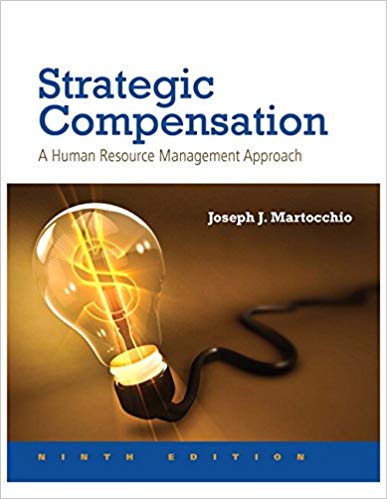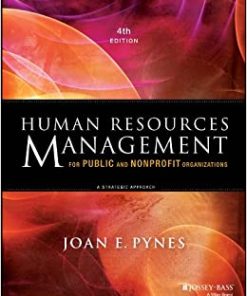(EBook PDF) Strategic Compensation A Human Resource Management Approach 9th Edition by Joseph Martocchio 013432059X 9780134320595 full chapters
$50.00 Original price was: $50.00.$25.00Current price is: $25.00.
Strategic Compensation: A Human Resource Management Approach 9th Edition by Joseph J. Martocchio – Ebook PDF Instant Download/DeliveryISBN: 013432059X, 9780134320595
Full download Strategic Compensation: A Human Resource Management Approach 9th Edition after payment

Product details:
ISBN-10 : 013432059X
ISBN-13 : 9780134320595
Author: Joseph Martocchio
NOTE: Before purchasing, check with your instructor to ensure you select the correct ISBN. Several versions of Pearson’s MyLab & Mastering products exist for each title, and registrations are not transferable. To register for and use Pearson’s MyLab & Mastering products, you may also need a Course ID, which your instructor will provide. Used books, rentals, and purchases made outside of Pearson If purchasing or renting from companies other than Pearson, the access codes for Pearson’s MyLab & Mastering products may not be included, may be incorrect, or may be previously redeemed. Check with the seller before completing your purchase. For courses in Human Resource Management. This package includes MyManagementLab®. Connecting Art and Science in Compensation Practices Strategic Compensation: A Human Resource Management Approach demonstrates the art and science of compensation practice and its role in a company’s competitive advantage. Through focused activities and supporting course material, readers build a solid foundation to become proficient compensation professionals.
Strategic Compensation: A Human Resource Management Approach 9th Table of contents:
I Setting the Stage for Strategic Compensation
1 Strategic Compensation A Component of Human Resource Systems
Learning Objectives
Defining strategic Compensation
What is Compensation?
What Is Strategic Compensation?
Compensation as A Strategic Business Partner
Strategic Compensation Decisions
Competitive Business Strategy Choices
Lowest-Cost Strategy
Differentiation Strategy
Compensation Decisions that Support the Firm’s Strategy
Employee Roles Associated with Competitive Strategies
Building Blocks and Structure of Strategic Compensation Systems
Building Blocks: Core Compensation and Employee Benefits
Core Compensation
Employee Benefits
Fundamental Compensation System Design Elements
Internal Consistency
Market Competitiveness
Recognizing Employee Contributions
Alternative Pay Structure Configurations
Fitting The Compensation Function in an Organization’s Structure
How HR Professionals Fit into the Corporate Hierarchy
The Compensation Profession
How the Compensation Function Fits into HR Departments
Compensation, Recruitment, and Selection
Compensation and Performance Appraisal
Compensation and Training
Compensation and Career Development
Compensation and Labor–Management Relations
Compensation and Employment Termination
Compensation and Legislation
Stakeholders of the Compensation System
Employees
Line Managers
Executives
Unions
U.S. Government
End of Chapter Review
Summary
Key Terms
MyManagementLab Chapter Quiz!
Discussion Questions
Case Competitive Strategy at Sportsman Shoes
Questions:
Crunch the Numbers! Calculating the Costs of Increasing the Total Compensation Budget at Butcher Enterprises
Questions:
Writing Assignments
Endnotes
2 Contextual Influences on Compensation Practice
Learning Objectives
Interindustry Wage Differentials
Pay Differentials Based on Occupational Characteristics
Geographic Pay Differentials
Labor Unions
Employment Laws Pertinent to Compensation Practice
Income Continuity, Safety, and Work Hours
Fair Labor Standards Act of 1938
Minimum Wage
Overtime Provisions
Child Labor Provisions
Pay Discrimination
Equal Pay Act of 1963
Civil Rights Act of 1964
Bennett Amendment
Age Discrimination in Employment Act of 1967 (as Amended in 1978, 1986, and 1990)
Civil Rights Act of 1991
Accommodating Disabilities and Family Needs
Pregnancy Discrimination Act of 1978
Americans with Disabilities Act of 1990
Family and Medical Leave Act of 1993
Prevailing Wage Laws
Davis–Bacon Act of 1931
Walsh–Healey Public Contracts Act of 1936
End of Chapter Review
Summary
Key Terms
MyManagementLab Chapter Quiz!
Discussion Questions
Case Exempt or Nonexempt?
Questions:
Crunch the Numbers! Whether to Work Overtime or Hire Additional Employees
Questions:
Writing Assignments
Endnotes
II Bases for Pay
3 Traditional Bases for Pay Seniority and Merit
Learning Objectives
Seniority and Longevity Pay
Historical Overview
Who Participates?
Effectiveness of Seniority Pay Systems
Design of Seniority Pay and Longevity Pay Plans
Advantages of Seniority Pay
Fitting Seniority Pay with Competitive Strategies
Merit Pay
Who Participates?
Exploring the Elements of Merit Pay
Performance Appraisal
Types of Performance Appraisal Plans
Trait Systems
Comparison Systems
Behavioral Systems
Goal-Oriented Systems
Exploring the Performance Appraisal Process
Four Activities to Promote Nondiscriminatory Performance Appraisal Practices
Sources of Performance Appraisal Information
Errors in the Performance Appraisal Process
Bias Errors
Contrast Errors
Errors of Central Tendency
Errors of Leniency or Strictness
Strengthening The Pay-For-Performance Link
Link Performance Appraisals to Business Goals
Analyze Jobs
Communicate
Establish Effective Appraisals
Empower Employees
Differentiate among Performers
Possible Limitations of Merit Pay Programs
Failure to Differentiate among Performers
Poor Performance Measures
Supervisors’ Biased Ratings of Employee Job Performance
Lack of Open Communication between Management and Employees
Undesirable Social Structures
Mounting Costs
Factors Other than Merit
Undesirable Competition
Little Motivational Value
End of Chapter Review
Summary
Key Terms
MyManagementLab Chapter Quiz!
Discussion Questions
Case Appraising Performance at Precision
Questions:
Crunch the Numbers! Costs of Longevity and Merit Pay
Questions:
Writing Assignments
Endnotes
4 Incentive Pay
Learning Objectives
Exploring Incentive Pay
Contrasting Incentive Pay with Traditional Pay
Individual Incentives
Defining Individual Incentives
Types of Individual Incentive Plans
Piecework Plans
Management Incentive Plans
Behavioral Encouragement Plans
Referral Plans
spot bonuses
Advantages of Individual Incentive Pay Programs
Disadvantages of Individual Incentive Pay Programs
Group Incentives
Defining Group Incentives
Types of Group Incentive Plans
Team-Based or Small-Group Incentive Plans
Gain Sharing Plans
The Scanlon Plan
The Rucker Plan
Advantages of Group Incentives
Disadvantages of Group Incentives
Company-wide Incentives
Defining Company-wide Incentives
Types of Company-wide Incentive Plans
Profit Sharing Plans
Calculating Profit Sharing Awards
Advantages of Profit Sharing Plans
Disadvantages of Profit Sharing Plans
Employee Stock Option Plans
Designing Incentive Pay Programs
Group versus Individual Incentives
Level of Risk
Complementing or Replacing Base Pay
Performance Criteria
Time Horizon: Short Term versus Long Term
End of Chapter Review
Summary
Key Terms
MyManagementLab Chapter Quiz!
Discussion Questions
Case Individual or Team Reward?
Questions:
Crunch the Numbers! Calculating Piecework Pay Awards
Questions:
Writing Assignments
Endnotes
5 Person-Focused Pay
Learning Objectives
Defining Person-Focused Pay: Competency-Based, Pay-For-Knowledge, and Skill-Based Pay
Usage of Person-Focused Pay Programs
Reasons to Adopt Person-Focused Pay Programs
Technological Innovation
Increased Global Competition
Varieties of Person-Focused Pay Programs
Contrasting Person-Focused Pay With Job-Based Pay
Advantages and Disadvantages of Person-Focused Pay Programs
Advantages
Disadvantages
End of Chapter review
MyManagementLab
Summary
Key Terms
MyManagementLab Chapter Quiz!
Discussion Questions
Case Person-Focused Pay at Mitron Computers
Questions:
Crunch the Numbers! Training Budget Costs
Questions:
Writing Assignments
Endnotes
III Designing Compensation Systems
6 Building Internally Consistent Compensation Systems
Learning Objectives
Internal Consistency
Job Analysis
Steps in the Job Analysis Process
Determine a Job Analysis Program
Select and Train Analysts
Direct Job Analyst Orientation
Conduct the Study: Data Collection Methods and Sources of Data
Summarize the Results: Writing Job Descriptions
Legal Considerations for Job Analysis
Job Analysis Techniques
U.S. Department of Labor’s Occupational Information Network (O*NET)
Experience Requirements
Occupational Requirements
Occupation-Specific Information RequirementS
Workforce Characteristics
Worker Characteristics
Worker Requirements
Using O*NET
Job Evaluation
Compensable Factors
The Job Evaluation Process
Determining Single versus Multiple Job Evaluation Techniques
Choosing the Job Evaluation Committee
Training Employees to Conduct Job Evaluations
Documenting the Job Evaluation Plan
Communicating with Employees
Setting Up the Appeals Process
Job Evaluation Techniques
The Point Method
Step 1: Select Benchmark Jobs
Step 2: Choose Compensable Factors Based on Benchmark Jobs
Step 3: Define Factor Degrees
Step 4: Determine the Weight of Each Factor
Step 5: Determine Point Values for Each Compensable Factor
Step 6: Verify Factor Degrees and Point Values
Step 7: Evaluate All Jobs
Balancing Internal and Market Considerations Using the Point Method
Alternative Job-Content Evaluation Approaches
Simple Ranking Plans
Paired Comparison and Alternation Ranking
Classification Plans
Alternatives to Job Evaluation
Internally Consistent Compensation Systems and Competitive Strategy
End of Chapter Review
Summary
Key Terms
MyManagementLab Chapter Quiz!
Discussion Questions
Case Internal Consistency at Customers First
Questions:
Crunch the Numbers! Modifying a Job Evaluation Worksheet
Writing Assignments
Endnotes
7 Building Market-Competitive Compensation Systems
Learning Objectives
Market-Competitive Pay Systems: The Basic Building Blocks
Compensation Surveys
Preliminary Considerations
What Companies Hope to Gain from Compensation Surveys
Custom Development versus Use of an Existing Compensation Survey
Using Published Compensation Survey Data
Survey Focus: Core Compensation or Employee Benefits
Sources of Published Compensation Surveys
Employment Cost Trends
National Compensation Data
Wages By Area and Occupation
Earnings By Demographics
Earnings By Industry
County Wages (Quarterly Census of Employment and Wages)
Employee Benefits National Compensation Survey
Compensation Costs in Other Countries
Compensation Surveys: Strategic Considerations
Defining the Relevant Labor Market
Choosing Benchmark Jobs
Compensation Survey Data
Using the Appropriate Statistics to Summarize Survey Data
Updating the Survey Data
Integrating Internal Job Structures with External Market Pay Rates
Compensation Policies and Strategic Mandates
Pay Level Policies
Pay Mix Policies
End of Chapter Review
Summary
Key Terms
MyManagementLab Chapter Quiz!
Discussion Questions
Case Nutriment’s New Hires
Questions:
Crunch the Numbers! Updating Salary Survey Data
Questions:
Writing Assignments
Endnotes
8 Building Pay Structures That Recognize Employee Contributions
Learning Objectives
Constructing a Pay Structure
Step 1: Deciding on the Number of Pay Structures
Exempt And Nonexempt Pay Structures
Pay Structures Based on Job Family
Pay Structures Based On Geography
Step 2: Determining a Market Pay Line
Step 3: Defining Pay Grades
Step 4: Calculating Pay Ranges for Each Pay Grade
Pay Compression
Green Circle Pay Rates
Red Circle Pay Rates
Step 5: Evaluating the Results
Designing Merit Pay Systems
Merit Increase Amounts
Timing
Recurring versus Nonrecurring Merit Pay Increases
Present Level of Base Pay
Rewarding Performance: The Merit Pay Grid
Employees’ Performance Ratings
Employees’ Positions within the Pay Range
Merit Pay Increase Budgets
Designing Sales Incentive Compensation Plans
Alternative Sales Compensation Plans
Salary-Only Plans
Salary-Plus-Bonus Plans
Salary-Plus-Commission Plans
Commission-Plus-Draw Plans
Commission-Only Plans
Sales Compensation Plans and Competitive Strategy
Determining Fixed Pay and the Compensation Mix
Influence of The Salesperson on the Buying Decision
Competitive Pay Standards within the Industry
Amount of Nonsales Activities Required
Designing Person-Focused Programs
Establishing Skill Blocks
Transition Matters
Skills Assessment
Aligning Pay with the Knowledge Structure
Access to Training
Training and Certification
In-House or Outsourcing Training
Certification and Recertification
Pay Structure Variations
Broadbanding
The Broadbanding Concept And Its Advantages
Limitations of Broadbanding
Two-Tier Pay Structures
The Two-Tier Pay System Concept and Its Advantages
Limitations of Two-Tier Pay Structures
End of Chapter Review
Summary
Key Terms
MyManagementLab Chapter Quiz!
Discussion Questions
Case A New Sales Representative
Questions:
Crunch the Numbers! Calculating Pay Range Minimums, Maximums, and Pay Range Overlap
Questions:
Writing Assignments
Endnotes
IV Employee Benefits
9 Discretionary Benefits
Learning Objectives
Origins of Discretionary Benefits
Categories of Discretionary Benefits
Protection Programs
Disability Insurance
Life Insurance
Retirement Programs
Paid Time Off
Services
Employee Assistance Programs
Family Assistance Programs
Tuition Reimbursement
Transportation Services
Outplacement Assistance
Wellness Programs
Financial Education
Legislation Pertinent To Discretionary Benefits
Internal Revenue Code
Employee Retirement Income Security Act of 1974 (ERISA)
Pension Protection Act of 2006
Defined Benefit Plans
Defined Contribution Plans
Designing and Planning the Benefits Program
Determining Who Receives Coverage
Financing
Employee Choice
Cost Containment
Communication
The Benefits and Costs of Discretionary Benefits
End of Chapter Review
Summary
Key Terms
MyManagementLab
Discussion Questions
Case Time Off At Superior Software Services
Questions:
Crunch the Numbers! 401(k) Plan Contributions: Allowable Amounts and Employer Match
Questions:
Writing Assignments
Endnotes
10 Legally Required Benefits
Learning Objectives
Origins of Legally Required Benefits
Categories of Legally Required Benefits
Social Security Programs
Unemployment Insurance
Old Age, Survivor, and Disability Insurance
Old Age Benefits
Survivor Benefits
Disability Benefits
Medicare
Medicare Part A Coverage
Medicare Part B Coverage
Medigap Insurance
Medicare Part C Coverage—medicare advantage
Medicare Prescription Drug Benefit
Financing OASDI and Medicare Programs
OASDI Programs
Medicare Programs
Workers’ Compensation
Workers’ Compensation Objectives and Obligations to the Public
How Workers’ Compensation Compares to Social Security Benefits
Recent Trends in Workers’ Compensation
Financing Workers’ Compensation Programs
Family and Medical Leave
Health Insurance
Health Insurance Program design alternatives
People also search for Strategic Compensation: A Human Resource Management Approach 9th:
strategic compensation a human resource management approach 9e book
strategic compensation a human resource management approach 11th edition
strategic compensation a human resource management approach 9th edition
strategic compensation a human resource management approach
strategic compensation a human resource management approach 10th edition
Tags:
Strategic Compensation,Human Resource,Management,Approach,Joseph Martocchio
You may also like…
Business & Economics - Management & Leadership
Cost Management A Strategic Emphasis 9th Edition by Steven Smith 1264112333 9781264112333
Business & Economics - Human Resources
Strategic Human Resource Management: Gaining a Competitive Advantage
Uncategorized
Human Resources Management for Public and Nonprofit Organizations: A Strategic Approach
Uncategorized
Business & Economics - Management & Leadership
Business & Economics - Management & Leadership
Uncategorized












